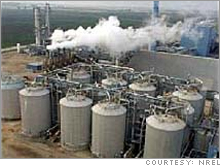Ethanol fuels rural renaissanceAlternative energy investments are revitalizing local economies. How long can the boom last?NEW YORK (CNNMoney.com) -- In Stanley, Wisconsin, residents had grown used to farms shutting down, people pulling up stakes and shuttered stores. But an ethanol plant that opened in 2002 is finally beginning to create a new vibe around town.
Mortgage Rates
The plant uses 15.5 million bushels of corn a year and puts out 42 million gallons of ethanol - which, with oil prices over $60 a barrel is a booming commodity. The plant employs 41 people directly and has also led to other hiring, such as drivers for the trucks who haul CO2, a byproduct of ethanol production, to a nearby paper plant. Other truckers take away the processed grain - a highly nutritious feedstock - to cattle farms. The added activity has boosted other businesses, such as a new breakfast spot. Empty storefronts are getting fewer. "Corn prices have gone through the roof, to more than $3 a bushel," says the town's mayor, David Jankoski. "They're finally getting a good price for their crops." A look at a U.S. county map of population change from 2000 to 2005 reveals that most non-metro - or rural - counties grew at a slower rate than the national average. Half of all these places lost population. In Nebraska, 84 percent (56 out of 67) of the counties of under 10,000 residents lost population. Kansas lost 28,392 in non-metro population, Iowa 21,697, Illinois 18,673 and North Dakota 17,866. Almost all the farm communities in the Midwest experienced similar population stagnation or loss. According to Bob Dinneen, president of the Renewable Fuels Association, ethanol is now revitalizing many of these rural communities - and not just in the Midwest. There are already about 100 U.S. ethanol plants in operation, up from 50 in 1999, and 78 more are under construction, reports Dinneen. They range from Texas and California to New York and Florida. They use corn, sorghum, soybeans and other crops to produce ethanol. Development of practical cellulosic ethanol production plants (from switch grass, corn stalks, municipal solid waste and other sources) is underway. "I've had the privilege of going out to grand openings of several ethanol plants," says Dinneen. "Standing in front of 1,000 farmers who have invested in these plants; the excitement is palpable." These farmers benefit in three ways: They get profits from the ethanol sales, higher prices for crops and the acreage they own becomes more valuable. In Iowa, land prices have risen about 60 percent during the 2000's, according to a report from Iowa State economist Mike Duffy. Compare that with Iowa single-family house prices, which have risen only about 4.5 percent a year over that period, according to the Office of Federal Housing Enterprise Oversight figures. There are, however, practical limitations with ethanol production that could eventually put a damper on the party, according to Dave Pimentel, a Cornell University agronomist. "I wish ethanol production was a boon to the nation and the environment; it is not," he says. Even if every grain of corn went into ethanol production, it would still not make the United States oil independent, he notes. "Look at it on a per-gallon basis," says Pimentel. "Our latest study indicates it takes 40 percent more fossil fuel energy to produce ethanol than it creates." Fossil fuels run farm and factory machinery, provide heat for the factories and transport ethanol to distant markets. Pimentel says that corn, the No. 1 ethanol crop in the United States, requires more herbicides and insecticides to grow, needs large amounts of fertilizer and is responsible for more soil erosion than any other U.S. crop. Furthermore, many of the areas benefiting most from ethanol production face water shortages; it takes 1,700 gallons of water to produce a gallon of ethanol, according to Pimentel. Whether any of these problems are solvable remains to be seen. What's undeniable, for now, is that many farm communities are enjoying a revival. "It's a temporary boon for the corn belt," says Pimentel, "that could last a while if the subsidies continue. But if Congress decides it's a boondoggle, someone may get caught." Companies making money now in renewable energy Home markets are being buoyed by the lowest interest rates of the year. |
|

